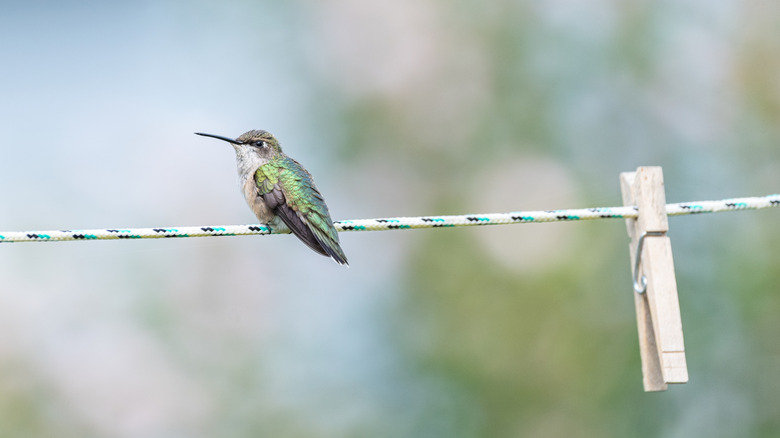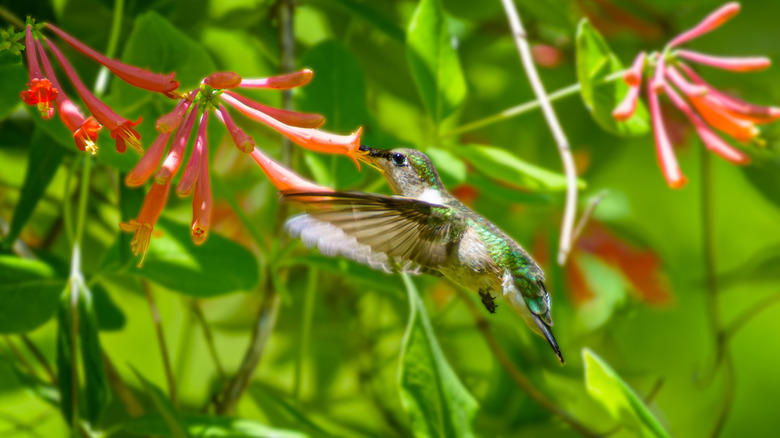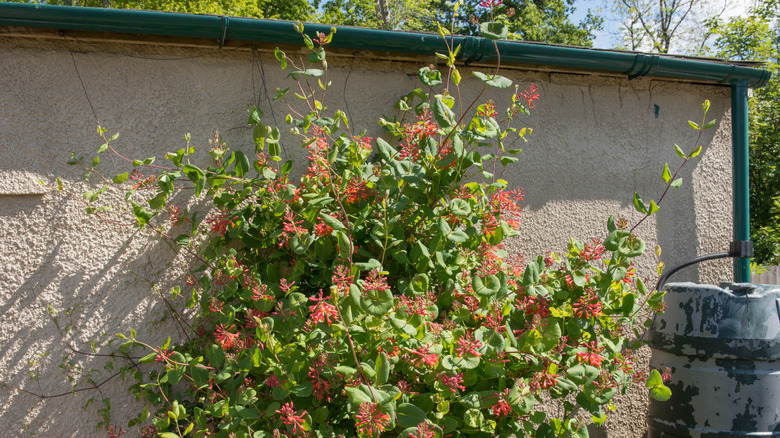Native Varieties Of Honeysuckle To Plant And Grow For A Hummingbird Paradise
Looking to get more hummingbirds to nest in your yard — or at least just visit? The fragrant, trumpet-shaped flowers of honeysuckle (Lonicera spp.) are a great attraction. Experienced gardeners may be wary of plants in the Lonicera family because Japanese honeysuckle (Lonicera japonica) is listed as invasive across much of North America. However, there are many native honeysuckle species that are much safer for planting for U.S. yards and gardens. Top picks include vigorous grower trumpet honeysuckle, hummer favorite fly honeysuckle, cold- and elevation-hardy hairy honeysuckle, and central U.S. grower yellow honeysuckle.
It may seem like hummingbirds hover around any available flower, but they can actually be quite picky. To optimize feeding, hummingbirds prefer flowers that produce large amounts of nectar, allowing them to eat more at once and better maintain their energy levels. Because of their long, narrow beaks, they gravitate toward tubular flowers, making nectar-rich, trumpet-shaped honeysuckle flowers a perfect option for them — and a great way for gardeners to attract these tiny birds to their gardens. Not all honeysuckle plants will thrive in every part of the U.S., so choose one native to your area. Native honeysuckles are not only better adapted to local conditions but also more likely to attract hummingbirds, which have evolved alongside specific native plant species as pollinators.
Native honeysuckle options for different parts of the U.S.
When it comes to planting native honeysuckle, you have a few options. Like many other honeysuckle plants, trumpet honeysuckle (Lonicera sempervirens) is a vigorous vine perfect for growing in USDA Hardiness Zones 4 to 9. Native to the eastern U.S., the vine is salt-tolerant, making it a good choice for those who live near the coast. Because of its bright flowers, ranging from yellow and orange to red and burgundy, trumpet honeysuckle is particularly attractive to hummingbirds. For gardeners in the Northeast, fly honeysuckle (Lonicera canadensis) would be a better option. Growing best in Zone 3, fly honeysuckle boasts flowers that are a favorite of ruby-throated hummingbirds.
As its name implies, hairy honeysuckle (Lonicera hirsuta) is a little fuzzier than its cousins, with hairs on its stems, leaves, and petioles. Perhaps because of its furry coat, this species of honeysuckle does well in cold climates and at higher elevations. It thrives in Zones 2 to 6. Those in the southeastern U.S. can grow vining yellow honeysuckle (Lonicera flava), which is native there. It will also grow well anywhere in Zones 5 to 8. Though hummingbirds prefer flowers in red tones, the blooms of yellow honeysuckle are still attractive to them. Pair your honeysuckle with unique hummingbird feeders to add some serious whimsy to any yard and support hummingbirds in late fall and winter when the plant's flowers are scarce.
Growing native honeysuckles in your yard for hummingbirds
While the different native honeysuckle species may have some unique growing needs, the care requirements for these shrubs and vines overlap in many areas. In most cases, the ideal time to plant honeysuckle is in the spring or early summer. However, some cold-hardy species can be planted in the fall, at least six weeks before the first frost. Choose a spot in your garden that gets full sun for more than six hours a day, especially if you want the plant to overflow with hummingbird-attracting flowers each season. Most honeysuckle varieties will do okay in shadier areas, but are less likely to produce abundant blooms. Pruning your vine back heavily in winter every two to three years may also increase flowering.
Honeysuckles prefer moist, well-draining soil. If your garden doesn't provide the right conditions, build a raised berm for your plant. Lay mulch around the base of your honeysuckle after planting it, keeping the mulch away from the stem to prevent rot. When the plant is young and still establishing its root system in the garden, water it once a week. After the first growing season, it will require less frequent watering — for example, only during drought-like conditions. You'll need to provide climbing native honeysuckle species with a trellis or similar structure. Buy or make it when you get the sapling from the nursery, so you have it on hand once the vine starts to grow rapidly. Alternatively, if you need to cover a large area, consider growing it as a bright-blooming ground cover that will help minimize soil erosion in your yard.


